The Anaheim Ducks find themselves in the beginning of a transitional period as they enter the 2018-19 season. Last season featured the positive of managing a second-place finish in the Pacific Division despite injuries to critical players all year long. The playoffs, however, exposed the Ducks as a slow, undisciplined, and highly flawed team, as they were swept away by the San Jose Sharks.
Under a mandate from general manager Bob Murray to play faster, the Ducks, while still saddled with some pricey veteran contracts, will begin to see more young faces in their lineup on a regular basis. A continuation of last season’s injury bug will also further accelerate the insertion of promising youngsters into key roles, giving them valuable experience as they grow into players Anaheim will have to lean on in the long run.
Team 2017-18 Record: 44-25-13 (101 points, 2nd in the Pacific Division)
Injuries Still Plaguing Ducks
On that front, the status of center Ryan Kesler—who was sidelined for nearly half of last season following hip surgery and was a shell of his normal self when he did play—is shrouded in mystery as he continues to work to get himself to optimal playing condition. Some potentially positive news, though, is that he is skating and participating in some drills, though he is facing minimal contact at this point. Right winger Patrick Eaves, who missed almost all of last season with a serious health scare—the exact diagnosis of which proved elusive until it was ultimately deemed a vague “post-viral syndrome”—finds himself in much better condition but still in an “on/off” phase with respect to hockey activities.

Most recently, franchise mainstay Corey Perry was found to require knee surgery to repair meniscus and MCL injuries. That will keep him out of the lineup for about five months, meaning he would be back right around the Feb. 25 trade deadline if this prognosis holds. Perry might never again be the high-volume scorer he once was, but he can still put up around 50 points, agitate opponents, and be leaned on as a veteran voice in the locker room, so his absence is not insignificant. Beyond Perry, new forward Brian Gibbons hurt his hand blocking a shot in the team’s Sept. 27 preseason contest against the Los Angeles Kings. His status awaits further evaluation.
In non-injury news, Anaheim still finds itself staring at an unexpected divide with 22-year-old winger Nick Ritchie, who remains an unsigned restricted free agent (RFA). It seems to be only a matter of time before he signs, but until he is on the roster, that is another spot that could go to an inexperienced player hungry to prove his worth at the NHL level.
Just like a year ago, the Ducks will face what feels like an uphill climb from the very start. In a loaded division that has seen several teams make major improvements, the Ducks will have their work cut out for them when it comes to simply qualifying for the postseason. That might be a difficult pill for fans to swallow after watching their team win five consecutive division titles before last year, but the silver lining is the excitement that comes with watching homegrown talent develop.
Offseason Moves
Key Roster Additions:
-
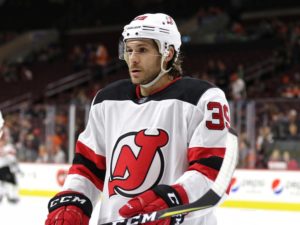
Brian Gibbons was one of the Ducks’ offseason additions. (Amy Irvin / The Hockey Writers) Brian Gibbons
- Carter Rowney
- Luke Schenn
- Andrej Sustr
Key Re-Signings/Extensions
- Adam Henrique (five-year extension takes effect starting in 2019-20 season)
- Ondrej Kase (three-year contract)
- Brandon Montour (two-year contract)
Key Roster Losses:
- Francois Beauchemin (retired)
- Kevin Bieksa (contract expired; currently UFA)
- J.T. Brown (signed with Minnesota Wild as UFA)
- Jason Chimera (contract expired; currently UFA)
- Derek Grant (signed with Pittsburgh Penguins as UFA)
- Chris Kelly (retired)
Key Player in Limbo:
- Nick Ritchie (unsigned RFA)
Key Organization Changes:
- Assistant coach changes:
- Assistant coach Steve Konowalchuk not retained
- Assistant coach Trent Yawney not retained
- Marty Wilford named assistant coach
Related: Ducks Sign Luke Schenn, Gibbons, Rowney & Others
Forwards:
The Ducks are going to see more youth in their lineup thanks to a combination of desire and necessity. At the start of the year, that new look will be especially glaring assuming the absences of Kesler, Eaves, Perry and Ritchie.
Projected Lines (Without Kesler, Eaves, Perry, and Ritchie):
| LW | C | RW |
| Rickard Rakell | Ryan Getzlaf | Troy Terry |
| Max Comtois | Adam Henrique | Jakob Silfverberg |
| Andrew Cogliano | Sam Steel | Ondrej Kase |
| Brian Gibbons | Carter Rowney | Kiefer Sherwood |
Given the in-flux state of the Ducks’ available forwards, Troy Terry could very well see some time on the first line with Ryan Getzlaf. The 21-year-old former University of Denver Pioneer has a great chance to establish himself as a full-time NHL player if he can produce offensively in the early part of the season. He scored a nice goal off a feed from Getzlaf in a preseason victory against the Kings on Sept. 29, so hopefully for him and Ducks fans, that’s a sign of things to come.
Center Sam Steel also scored in that game, and he appears to be the Ducks’ third-line center to start the season. Max Comtois—a gifted offensive player who the Ducks selected in the second round of the 2017 draft—also has an excellent shot to be on the opening-night roster, as does Kiefer Sherwood, a 23-year-old who finished up his last collegiate season with Miami University (Ohio) and saw some time with the San Diego Gulls in the AHL last year. These players have all impressed in camp and seem to be the best bets to fill the voids left by injuries and Ritchie’s contract holdout.
Other options to fill in include Ben Street and Joseph Blandisi. If and when the Ducks’ aforementioned regulars return, look for Comtois and Sherwood to come out of the lineup and perhaps for Rowney or Gibbons to be the 13th forward. Then the Ducks will be left with an interesting decision regarding Steel. The return of Kesler would bump him to fourth on the center depth chart, but fourth-line minutes in the NHL might not be as fruitful for his development as first-line minutes in the AHL.
Ryan Getzlaf
No matter what happens with the Ducks’ youngsters, Getzlaf will once again serve as the club’s top center (barring injury, of course). Anaheim’s 33-year-old captain has thus far been able to avoid the decline and chronic injury problems that have struck down fading veteran stars Perry and Kesler.
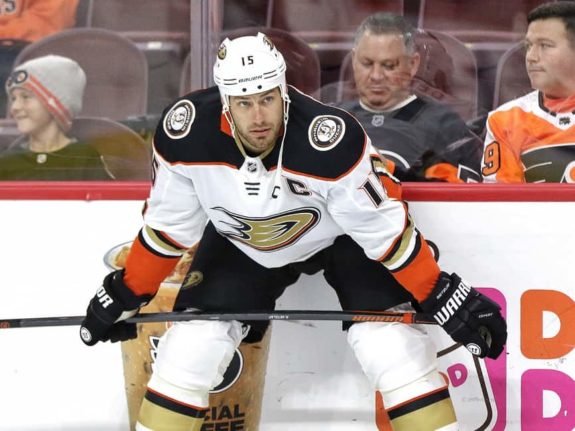
While he did suffer a facial fracture last season and missed a total of 26 games, Getzlaf was nevertheless better than a point-per-game player when he did play, tally a total of 61 points in 56 games. Getzlaf is a setup-man extraordinaire, as 50 of his 61 points were assists. He and emerging star Rickard Rakell have formed a dynamite duo on the top line, and perhaps now the savvy veteran can help jumpstart the career of a youngster like Terry, who could fill in as the other wing as the season commences.
Ondrej Kase
Kase, still just 22, broke out last season for 20 goals. Beyond the scoring production, the Czech right wing was a consistent source of speed and energy for an Anaheim club that very much needed those elements. If he plays on a line with Sam Steel, then that could be an exciting young tandem for Ducks fans to watch. If he plays with Adam Henrique, they should be able to build on their strong chemistry from last season.
Adam Henrique
Speaking of Henrique, the 28-year-old pivot gave the Ducks everything they could have hoped for after they acquired him as part of a trade with the New Jersey Devils that saw defenseman Sami Vatanen go the other way. He picked up 20 goals in just 57 games after joining Anaheim, adding 16 helpers along the way.
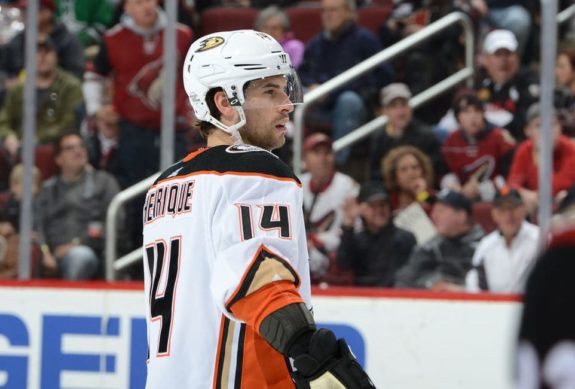
With Kesler out for an indefinite period of time, the Ducks will need to rely on Henrique to be their No. 2 center. If he keeps up his play from last season, he should be more than up to the challenge.
Defense:
Head coach Randy Carlyle has options and is not committed to specific pairings, but based on last year’s tendencies and the success of the Hampus Lindholm/Josh Manson partnership, it’s likely we’ll see pairings like the below for at least parts of the season. Carlyle will inevitably mix things up from time to time as the season goes on.
Projected Pairings:
| LD | RD |
| Hampus Lindholm | Josh Manson |
| Cam Fowler | Brandon Montour |
| Marcus Pettersson | Luke Schenn |
Andrej Sustr (or Luke Schenn, or perhaps even Marcus Pettersson) would be the seventh defenseman on the roster.
Hampus Lindholm
Lindholm remains one of the NHL’s most overlooked defensemen. The steady Swede is still only 24 years old and should be manning Anaheim’s most reliable defensive pair along with Josh Manson.
Always reliable defensively, Lindholm has also shown some offensive ability ever since breaking into the league in 2013-14, hovering around the 30-point mark in each season. Last year, he scored a career-high 13 goals in just 69 games. As he continues to serve as a stellar shutdown defender for the Ducks, he is also showing signs of growth on the other side of the puck and thus further evolving as an all-around star defenseman. An interesting and exciting storyline to watch this season is whether and to what extent Lindholm can continue to increase his goal and point production.
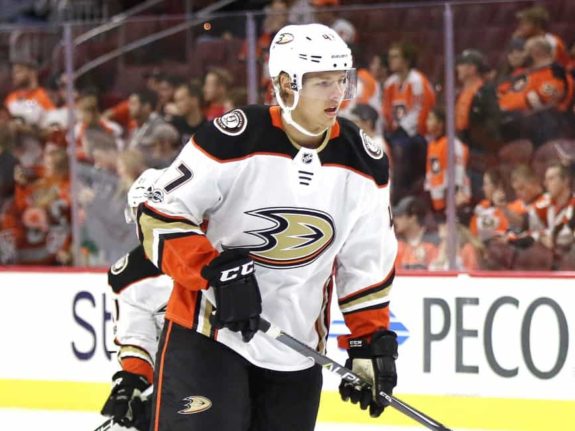
An adjustment to a new system could very well boost Lindholm’s offensive production, as he should find himself with the puck on his stick more often.
“Get movement on the blue line,” Lindholm said of the system change. “Be shifty on the blue line. Sometimes you can go for a little skate. Go through the middle and come up again. That’s going to create so much space for our forwards. If we can keep doing stuff like that, I think we’re going to be able to dress six (defensemen) that’s going to be really good skating and puck-moving D-men as much as we can.” (from ‘Ducks system change still a work in progress as camp focus shifts to preseason games’, The Athletic, Sept. 21, 2018.)
Brandon Montour
Montour, also 24, burst onto the scene in the 2017 playoffs, acquitting himself well in high-leverage situations while picking up seven assists in 17 contests along the way. That, in part, helped land him a full-time NHL gig last season. The smooth-skating and offensively-inclined Montour appeared in 80 regular-season games, registering nine goals and 23 assists. Twelve of his 32 points came on the power play, and he should once again find himself as a critical part of the Ducks’ power-play attack—particularly by setting up on the left side so he can shoot one-timers as with his dangerous right-handed shot.
Montour, who signed a new two-year contract in the offseason, will firmly be in the top-four this season and appears likely to pair with Cam Fowler. Montour played the most minutes with Francois Beauchemin last season, but since he has retired, Montour’s role becomes more prominent. The player with whom he was paired the most often besides Beauchemin was Fowler, so that’s something that might continue to see in 2018-19, even if Carlyle is still undecided and shuffling the pairs.
As with most offensively-minded blueliners, Montour will need to keep improving on the defensive side of things. During 5-on-5 play last season, no Ducks player was on the ice for more high-danger scoring chances against than Montour (251). His high-danger chance share of 47.27 percent also needs to improve quite a bit.
Marcus Pettersson
Pettersson did not look out of place after being called up and playing in 22 games last season. Now, the lanky 22-year-old Swede will look to become a regular part of Anaheim’s blue line and help round out a group that has a very solid top four in Lindholm, Manson, Fowler, and Montour.
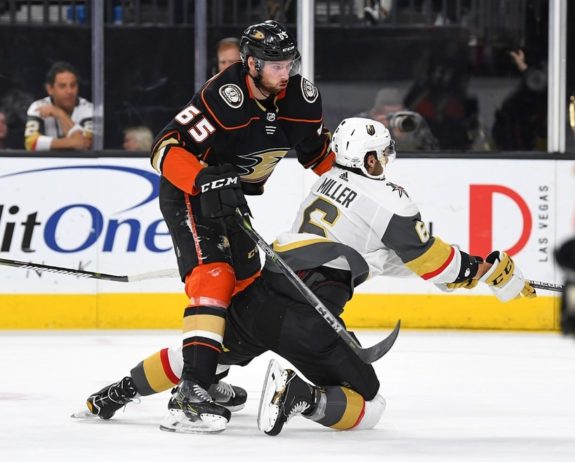
Pettersson has some offensive ability but will mostly serve as a steady, cerebral defenseman—a player who is implicitly effective if he goes relatively unnoticed during games. He will have to improve in terms of not being caught in his own end for extended stretches, as his Corsi-for percentage of 44.42 at 5-on-5 leaves a lot to be desired. Of course, given the Ducks’ struggles in this area as a whole last year, that was not all Pettersson’s fault.
The left side of the third pair seems to be Pettersson’s spot to lose, so it will be interesting to watch if he seizes this opportunity in the regular season.
Goaltending:
Goaltending should be the least of the Ducks’ concerns, as it was what got them to the postseason last year.
John Gibson might not have been a finalist for the Vezina Trophy last season, but he was one of the most consistent goaltenders in the game. While he dealt with some knick-knack, tough-luck injuries, he still suited up for a career-high 60 regular-season games and led the Ducks to 31 wins while sporting a sparkling save percentage of .926—good for fourth-best in the NHL among goalies who played in at least 40 games.
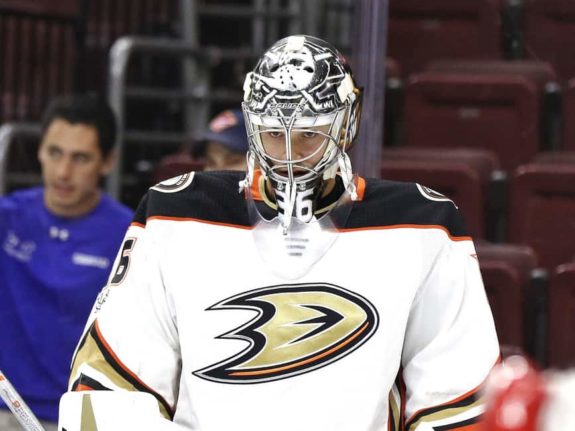
The Pittsburgh native is still only 25 years old and is now locked up to an eight-year contract worth an average of $6.4 million per year. Given Gibson’s age and ever-improving performance, that contract should deliver great value for Anaheim over its entire duration. The Ducks’ goalie of the present and future was the main reason why they were able to wade through injury-infested waters on their way to a second-place finish in the Pacific Division in 2017-18. With injuries manifesting themselves in great numbers once again, Anaheim will continue to lean heavily on Gibson.
When Gibson needs rest, the Ducks have a great backup netminder in 38-year-old veteran Ryan Miller, who is in the final year of his two-year contract. Once one of the top goaltenders in the league, Miller by necessity sees a reduced workload as he plays through the twilight of his career. That reduced workload, though, allows him to continue to play at a very high level. In 28 games last season (including 21 starts), Miller notched 12 wins and posted an astounding save percentage of .928.
Breakout Player: Sam Steel
The Ducks selected Steel in the first round of the 2016 draft (30th overall). Since then, he has validated that selection at the junior level; he took home the CHL Top Scorer Award for the 2016-17 season when he stuffed the stat sheets with a whopping 131 points (50 goals and 81 assists) in just 66 games for the Regina Pats. Some quick math concludes that that is about two points per game.
Last season with the Pats, his numbers came down a bit, but not to a level that was concerning: he still scored 83 points (33 goals and 50 assists) in 54 games. While Steel might still benefit from some AHL seasoning, he will, by necessity, open the season with the Ducks. Now 20 years old, this is his first real opportunity to show whether he can translate his high-scoring ways at the NHL level.
“It’s definitely a different mindset coming into this year. I think my game has matured and it seems like it’s closer and closer (to being NHL-ready),” said Steel just before the beginning of training camp. “The NHL’s a big, fast league and you have to create space out there.”
Steel finished the preseason with two goals, including one on Sept. 29 that capped off an impressive individual sequence, with the youngster picking off a pass in the offensive zone and roofing home a shot from the slot.
Again, Steel’s roster spot becomes less of a sure thing when veterans begin to return to the lineup, but if he can prove himself with this early-season opportunity, he could very well give Carlyle and Murray no other choice than to keep him with the big club.
Player With Most to Prove: Nick Ritchie*
Ritchie gets an asterisk because he is still an unsigned RFA and thus not even on the Ducks’ roster (as of Sept. 30). Assuming he does eventually ink a new deal with Anaheim and finds himself back on the ice, the 10th overall pick from the 2014 draft will have a lot to prove.
Ritchie will have to show meaningful progress after his goal total dropped from 14 in 2016-17 to 10 in 2017-18. He will have to demonstrate that he can exercise some discipline and avoid taking silly, completely unwarranted penalties. Beyond that, he will have to show a significant ascent towards the high ceiling his draft status promised, why he felt the need to hold out for a bigger contract, and performance-based justification for whatever deal he does end up signing.
First Players in the ‘Call-Up’ Line: Jacob Larsson, Kevin Roy, Giovanni Fiore
Excluding youngsters who could start the season with the Ducks but then may or may not be sent back to the minors (e.g., Terry, Comtois, Sherwood, and Steel), other prospects who could be in line for call-ups at some point during the season are defenseman Jacob Larsson, winger Kevin Roy, and forward Giovanni Fiore.
Larsson’s development has plateaued after he showed promise immediately following his 27th overall selection by the Ducks in the 2015 draft. Larsson even suited up for four games with the Ducks in 2016-17. Since then, however, injuries and then knee surgery have set him back, and he hasn’t quite looked the same since. While still only 21 years old, Larsson might well be facing a make-or-break season in the AHL to show that he can get back on track towards a hopefully prosperous NHL career.
Roy is somewhat of a late bloomer at age 25 and has some positive NHL experience to his credit. The Quebec native found the back of the net six times in 25 games for the Ducks last season, filling in for a good chunk of the season as the team dealt with injuries throughout the lineup. Roy scored at a high rate in the AHL last season, with 37 points in 45 games, so he figures to be a strong candidate to fill in if further call-ups are needed.
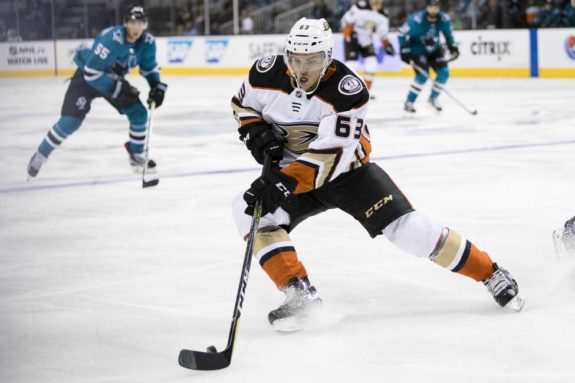
The 22-year-old Fiore also seems to be on the cusp of an NHL career, although he hasn’t quite capitalized on the momentum he built after impressing in training camp last season. This time around, he was somewhat of an early cut, being sent back down to the Gulls on Sept. 24. If he can prove himself further at the AHL level and increase his offensive totals from last season (18 goals and 12 assists in 65 games), he’ll rise up the list of call-up options.
Other stop-gap call-up options include defenseman Andy Welinski (25), 20-year-old blueliner Josh Mahura, center Kalle Kossila (25), center Joseph Blandisi (24), and veteran center Ben Street (31) (assuming the latter two are not on the final NHL roster to start the season). Then there’s 18-year-old Isac Lundestrom, the Ducks’ first-round draft pick from this summer who has been a standout in training camp. He remains a long shot to see NHL time this season, as it’s more likely he’ll head back to Sweden to play the year in the SHL on a loan.
Season Outlook
While the Ducks have some young talent to help gradually usher in a fresh new era, their injuries combined with an improved Pacific Division will make this another season-long battle to get into the playoffs. Gibson will keep them in most games, but as a team in what appears to be the beginning of a transitional period, they will likely find themselves as a fringe playoff contender.
Team 2018-19 Record Prediction: 42-29-11 (95 points, 4th in the Pacific Division; will qualify for the playoffs as the second wild card in the West)
Be sure to comment below with your opinions on how the Anaheim Ducks will perform in the 2018-19 season, and/or head over to the THW Twitter feed or Facebook page to discuss the Ducks and anything else related to the NHL.